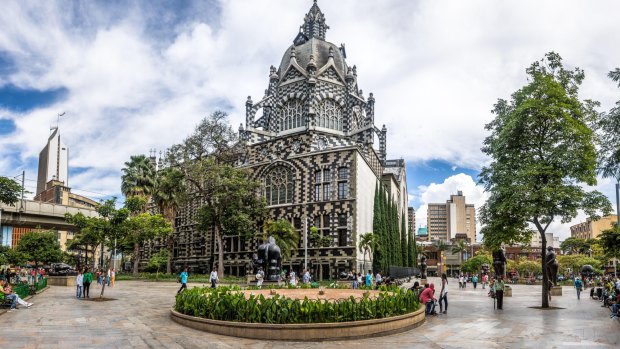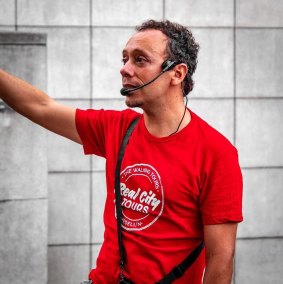This was published 4 years ago
Medellin, Colombia: How the world's most dangerous city turned itself around
By Rob McFarland

Botero Square and the Palace of Culture in Medellin.Credit: Alamy
"Everyone ready?" says Juan. "Be vigilant – we are now at papaya level four."
We're about to enter "the hole" – the local nickname for the pedestrianised heart of downtown Medellin. To my untrained eye, it looks like any other busy retail thoroughfare. But according to Juan, our guide from Real City Tours, it's also where some of the city's less desirable characters hang out, so we need to keep an eye on our belongings.
Papaya is the curious metaphor Colombians use to mean being taken advantage of. If you were to stand on a busy street corner counting money, you'd be "giving papaya". The rationale is that if you don't give papaya, someone else can't take papaya.

Tour guide, Real City Tours, Medellin.
As we stroll past department stores, fast food joints and street vendors, Juan points out the former palace of justice (ironically now a shopping centre selling mainly counterfeit goods), the impressive bell-topped Veracruz Church and a group of provocatively-dressed women he euphemistically refers to as "loving providers".
Around the corner is Botero Plaza, a large square filled with 23 sculptures donated by Fernando Botero, the Medellin artist famous for his exaggerated "chubby" nudes. Juan says each one is worth about $US2million.
It's hard to imagine what this area would have looked like 30 years ago when Time Magazine declared Medellin the world's most dangerous city. Between 1983 and 1993, more than 200 bombs went off in the city centre and about 43,000 people were killed.
Juan does an impressive job of explaining the cause of the conflict and the political rollercoaster that culminated in a 2016 peace deal between the government and FARC, the far-left guerrilla group responsible for much of the violence.
Of course, it's impossible to talk about Medellin's history and not mention its most notorious drug lord, Pablo Escobar. But so troubling is his memory for locals that Juan never refers to him by his real name. He simply calls him "the crazy criminal".
Like many Colombians, Juan and his family were deeply affected by the conflict. Two of his uncles were kidnapped by FARC and held underground for a year until the family paid a $US400,000 ransom. Four of his best friends were killed by gangs. Eventually, after being shot twice when he was 15, he fled to the US.
His honesty, humour and insight are what transform this experience from yet another "free" walking tour into the most informative and illuminating tour I do during my nine-day stay in Colombia. At the outset he explains there are "no forbidden questions" and he's refreshingly opinionated about the issues that have torn apart his country.
"Only now are we beginning to acknowledge and heal our wounds," he says. "Before it was too soon and too painful."
Medellin's transformation from a violent war-zone to one of the world's most forward-thinking cities is nothing short of remarkable. During the height of the conflict, it managed to build Colombia's first integrated metro system and has effectively used public art to gentrify many dilapidated areas. In 2013, it was named the world's most innovative city by the Urban Land Institute, beating New York and Tel Aviv.
The tour finishes in San Antonio Park, next to the remains of a large Botero sculpture of a bird that was blown up during a music festival in June 1995, killing 30 people and injuring more than 200. Botero provided an identical replacement, which now stands alongside it, but asked the mayor to leave the damaged one there. Known as The Birds of Peace, they're a powerful symbol – one representing the city's troubled past; the other its brighter, shinier future.
LATAM flies to Medellin from Melbourne and Sydney via Santiago and Bogota. See latam.com
TOUR
Tours run several times a day and last about 3.5 hours. There's no charge but tipping is encouraged. Advanced booking required. See realcitytours.com
VISIT
G Adventures/National Geographic Journeys' nine-day Colombia Journey from Bogota to Cartagena includes three nights in Medellin plus several exclusive experiences, such as a stay on a coffee farm and a private salsa class. From $3099 per person. See gadventures.com.au
Rob McFarland was a guest of G Adventures.
Sign up for the Traveller Deals newsletter
Get exclusive travel deals delivered straight to your inbox. Sign up now.